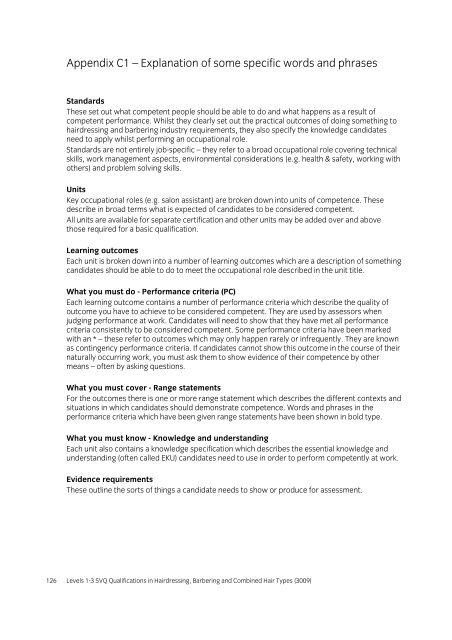3009 SVQ Assessment handbook v2 - City & Guilds
3009 SVQ Assessment handbook v2 - City & Guilds
3009 SVQ Assessment handbook v2 - City & Guilds
Create successful ePaper yourself
Turn your PDF publications into a flip-book with our unique Google optimized e-Paper software.
Appendix C1 – Explanation of some specific words and phrases<br />
Standards<br />
These set out what competent people should be able to do and what happens as a result of<br />
competent performance. Whilst they clearly set out the practical outcomes of doing something to<br />
hairdressing and barbering industry requirements, they also specify the knowledge candidates<br />
need to apply whilst performing an occupational role.<br />
Standards are not entirely job-specific – they refer to a broad occupational role covering technical<br />
skills, work management aspects, environmental considerations (e.g. health & safety, working with<br />
others) and problem solving skills.<br />
Units<br />
Key occupational roles (e.g. salon assistant) are broken down into units of competence. These<br />
describe in broad terms what is expected of candidates to be considered competent.<br />
All units are available for separate certification and other units may be added over and above<br />
those required for a basic qualification.<br />
Learning outcomes<br />
Each unit is broken down into a number of learning outcomes which are a description of something<br />
candidates should be able to do to meet the occupational role described in the unit title.<br />
What you must do - Performance criteria (PC)<br />
Each learning outcome contains a number of performance criteria which describe the quality of<br />
outcome you have to achieve to be considered competent. They are used by assessors when<br />
judging performance at work. Candidates will need to show that they have met all performance<br />
criteria consistently to be considered competent. Some performance criteria have been marked<br />
with an * – these refer to outcomes which may only happen rarely or infrequently. They are known<br />
as contingency performance criteria. If candidates cannot show this outcome in the course of their<br />
naturally occurring work, you must ask them to show evidence of their competence by other<br />
means – often by asking questions.<br />
What you must cover - Range statements<br />
For the outcomes there is one or more range statement which describes the different contexts and<br />
situations in which candidates should demonstrate competence. Words and phrases in the<br />
performance criteria which have been given range statements have been shown in bold type.<br />
What you must know - Knowledge and understanding<br />
Each unit also contains a knowledge specification which describes the essential knowledge and<br />
understanding (often called EKU) candidates need to use in order to perform competently at work.<br />
Evidence requirements<br />
These outline the sorts of things a candidate needs to show or produce for assessment.<br />
126 Levels 1-3 <strong>SVQ</strong> Qualifications in Hairdressing, Barbering and Combined Hair Types (<strong>3009</strong>)
















